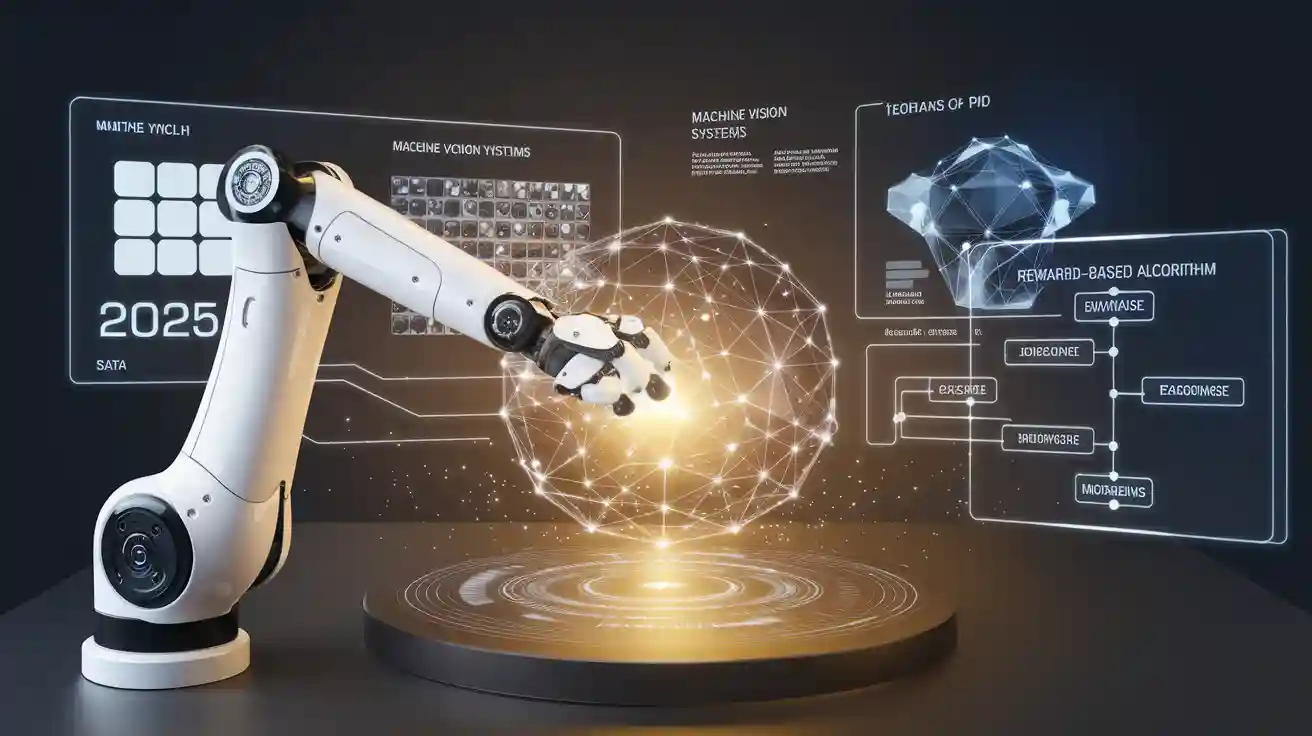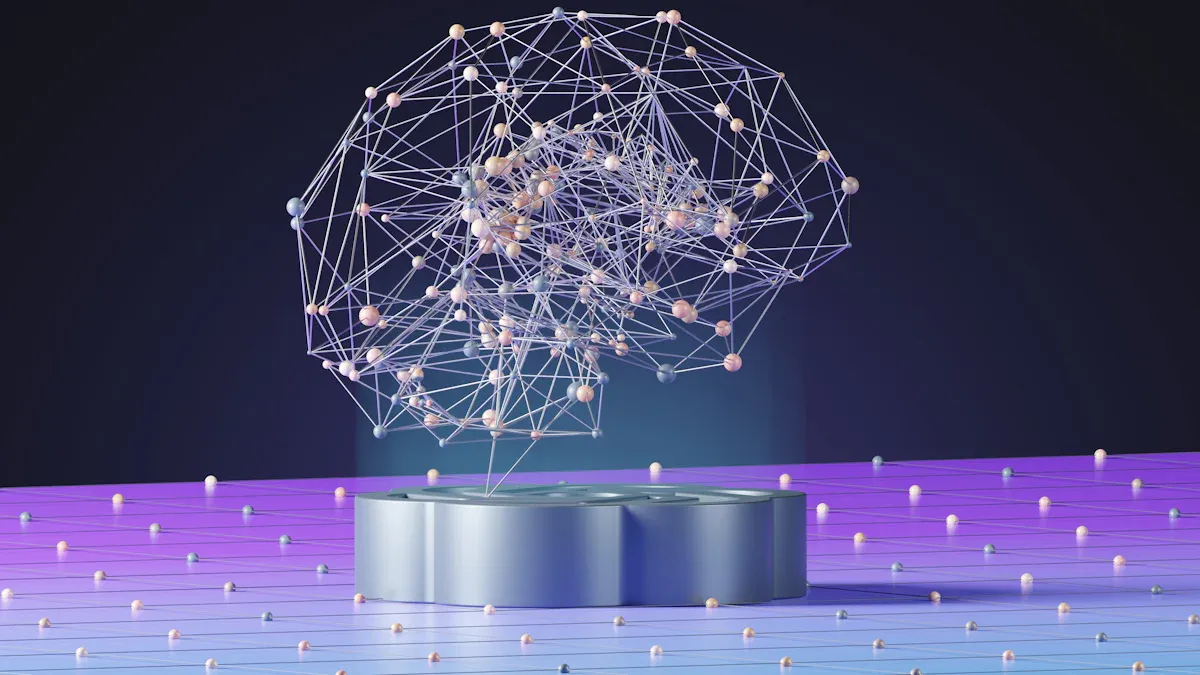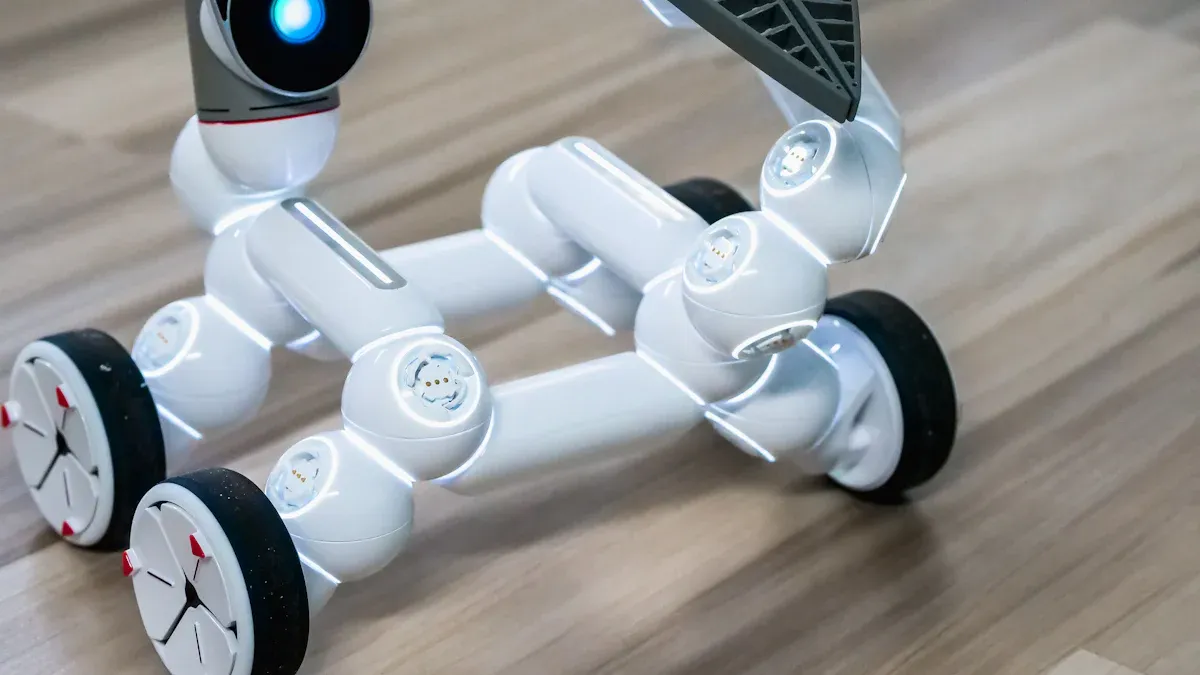
Imagine a system that sees the world, learns from feedback, and improves its performance continuously. A reward machine vision system does exactly that. It combines advanced image recognition with reinforcement learning to adapt and optimize tasks. In 2025, these systems play a crucial role in industries like healthcare, retail, and robotics. Their adoption is growing steadily. For example, nearly half of surveyed businesses expect moderate sales growth, while 43.4% predict significant increases for these systems this year. You interact with technology daily, and understanding these systems helps you grasp how they shape modern life.
Key Takeaways
- Reward machine vision systems learn from feedback to get better. This ability makes them important in healthcare and factories.
- Reinforcement learning helps these systems make smarter choices. It improves tasks, making them more accurate and efficient.
- These systems lower costs a lot. Prices used to be very high but now range from $50,000 to $100,000, so more businesses can afford them.
- Reward signals help guide these systems to improve their actions. This feedback helps them do harder tasks better over time.
- These systems can work in many industries and grow with businesses. They keep quality and performance steady as needs change.
Understanding Reward Machine Vision Systems
What is a Reward Machine Vision System?
A reward machine vision system combines advanced image processing with reinforcement learning to create intelligent systems capable of improving their performance over time. These systems analyze visual data, such as images or videos, and use a reward signal to guide their learning process. The reward signal acts as feedback, helping the system understand whether its actions are correct or need adjustment. This iterative process allows the system to refine its decision-making and achieve higher accuracy.
For example, a machine vision system equipped with a single-pixel detector has achieved an optical classification accuracy of over 96%. Similarly, a deep learning-based model for food detection reached 100% accuracy on a validation dataset and 94.4% on a test dataset. These results highlight the efficiency and precision of this technology in real-world applications.
By integrating rewards into machine vision technology, these systems can adapt to complex environments. They are not limited to static programming but instead evolve through continuous learning. This adaptability makes them invaluable in fields like automation, healthcare, and retail, where precision and efficiency are critical.
The Role of Reinforcement Learning in Machine Vision Systems
Reinforcement learning plays a pivotal role in enhancing the capabilities of a machine vision system. Unlike traditional programming, reinforcement learning enables a system to learn from its environment by interacting with it. The system receives rewards or penalties based on its actions, which helps it develop an optimal policy for achieving its goals. This process, known as policy optimization, ensures that the system improves over time.
Studies have demonstrated the effectiveness of reinforcement in machine vision applications. For instance, a study by Luo et al. showed that reinforcement learning reduced assembly errors in manufacturing by addressing part misalignment. Another study using a Deep Q-learning framework achieved a 95.9% test convergence accuracy, significantly improving the precision of shoe tongue manufacturing. These examples underscore how reinforcement learning enhances both accuracy and efficiency.
The training process in reinforcement learning involves repeated exposure to tasks, allowing the system to identify patterns and refine its decision-making. This iterative approach ensures that the system becomes more reliable and scalable over time. By leveraging reinforcement, machine vision systems can handle complex tasks, such as object detection and system integration, with remarkable precision.
In 2025, the integration of reinforcement learning into machine vision systems continues to drive advancements in automation and optimization. These systems are not just tools; they are dynamic technologies that adapt and evolve, making them essential for industries seeking innovation and efficiency.
How Reward Machine Vision Systems Work

Core Components of a Machine Vision System
A machine vision system relies on several key components to function effectively. Each part plays a critical role in ensuring the system can analyze visual data and make accurate decisions. Understanding these components helps you see how this technology operates.
-
Cameras and Sensors: These capture images or videos of the environment. Advanced systems often use multispectral or hyperspectral cameras to detect details invisible to the human eye. For example, multispectral cameras can identify bruises on fruit, while hyperspectral cameras measure fat content in avocados.
-
Processing Unit: This is the brain of the system. It processes the captured images using algorithms and models. AI-driven systems, such as those using convolutional neural networks (CNNs), achieve remarkable accuracy. For instance, CNN-based methods can reach an overall accuracy of 98%, significantly outperforming traditional approaches.
-
Lighting: Proper lighting ensures the system captures clear and consistent images. Techniques like time-of-flight (ToF) technology enhance precision in tasks like counting and dimensioning boxes.
-
Software and Algorithms: These interpret the visual data. AI-powered software uses reinforcement learning to improve performance over time. For example, a predictive model trained on 50,000 images achieved precision and recall metrics of 0.95 and 0.97, respectively.
-
Output Devices: These communicate the system’s findings, whether through alerts, reports, or direct integration with other systems. For instance, in assembly verification, the system can flag misaligned parts for correction.
Each component contributes to the system’s overall efficiency. Together, they enable tasks like defect detection, object recognition, and system integration with unparalleled speed and accuracy.
How Rewards Enhance Machine Vision Systems
Rewards are the driving force behind the learning process in a reward machine vision system. They guide the system’s behavior, helping it improve through trial and error. By incorporating reinforcement learning, these systems achieve higher levels of optimization and adaptability.
When a machine vision system performs a task, it receives a reward signal based on its success. This feedback helps the system refine its policy, or strategy, for completing the task. For example, in defect detection, the system learns to identify flaws more accurately by analyzing patterns in the reward signals it receives. Over time, this process leads to significant improvements in performance.
The integration of rewards also enhances efficiency. AI-driven systems now achieve accuracy rates of over 99.5%, compared to 85-90% for traditional methods. They process tasks faster, reducing the time per unit from 2-3 seconds to just 0.2 seconds. Additionally, the cost of implementing this technology has dropped dramatically. Systems that once cost $500,000 to $1,000,000 now range between $50,000 and $100,000, offering five times higher performance and bandwidth.
Rewards also enable machine vision systems to adapt to complex environments. For instance, in automation, 3D technology allows robots to perform bin picking with precision. In healthcare, these systems assist in diagnostics by identifying subtle anomalies in medical images. The ability to learn and adapt makes these systems invaluable across industries.
By leveraging rewards, machine vision technology evolves beyond static programming. It becomes a dynamic tool capable of continuous improvement, making it a cornerstone of modern automation and optimization efforts.
Applications of Reward Machine Vision Systems in 2025

Industrial Automation and Robotics
Automation has transformed industries, and reward machine vision systems are at the forefront of this revolution. These systems enhance industrial processes by combining machine vision technology with reinforcement learning. They enable robots to perform tasks like defect detection, assembly verification, and bin picking with unmatched precision. For example, in manufacturing, these systems identify misaligned parts and correct them in real time, reducing errors and improving efficiency.
The demand for automation continues to grow. The global machine vision system market, valued at $49.7 billion in 2023, is projected to reach $159.2 billion by 2032, with a compound annual growth rate (CAGR) of 13.9%. Additionally, the installation of industrial robots increased by 5% year-on-year in 2022, with over 553,000 robots deployed. These trends highlight the increasing reliance on automation to boost productivity and accuracy.
By leveraging rewards and policy optimization, these systems adapt to complex environments. They learn from feedback, refine their policies, and improve over time. This adaptability makes them essential for industries seeking to optimize operations and reduce costs.
Advancements in Healthcare Diagnostics
In healthcare, reward machine vision systems play a critical role in diagnostics. These systems analyze medical images, such as X-rays and MRIs, to detect anomalies with high accuracy. For instance, they identify early signs of diseases like cancer or cardiovascular conditions, enabling timely intervention.
Reinforcement learning enhances the system’s ability to learn from vast datasets. Through training, the system refines its detection capabilities, ensuring reliable results. This technology reduces diagnostic errors and supports healthcare professionals in making informed decisions.
The adaptability of these systems also extends to personalized medicine. By analyzing patient-specific data, they recommend tailored treatments. This level of precision improves patient outcomes and streamlines healthcare processes.
Retail Optimization and Customer Experience
Retailers use reward machine vision systems to enhance customer experiences and optimize operations. These systems analyze store traffic, monitor customer behavior, and provide actionable insights. For example, they use heat maps to visualize traffic patterns, helping retailers allocate staff effectively.
| Metric | Description |
|---|---|
| Traffic Data | Monitors and distinguishes between customers and sales associates to assess store traffic. |
| Register Alert | Notifies sales associates when customer lines at registers become lengthy. |
| Dwell Detection | Alerts staff when customers linger in high-value areas, indicating potential sales opportunities. |
| Heat Maps | Visual representation of customer traffic patterns to guide staffing and operational decisions. |
By integrating rewards, these systems adapt to changing customer behaviors. They learn from data, refine their policies, and improve over time. This optimization leads to better customer satisfaction and increased sales.
Benefits of Reward Machine Vision Systems
Efficiency and Accuracy in Operations
Reward machine vision systems excel in improving operational efficiency and accuracy. These systems operate tirelessly, identifying surface anomalies at microscopic levels and distinguishing acceptable variations from defects. Unlike human operators, they maintain consistent performance without fatigue or variability. For example, in manufacturing, implementing this technology has reduced product defect rates by 92% while increasing inspection throughput by 340%.
In retail, intelligent cameras analyze store traffic and optimize product placement. They also eliminate checkout lines by correlating visual data with point-of-sale systems. Additionally, these systems monitor environments, sending alerts for issues like open refrigerator doors or long checkout lines. This proactive approach ensures smooth operations and minimizes downtime.
The ability to process vast amounts of data quickly and accurately makes these systems indispensable. They not only enhance productivity but also reduce costs, offering significant returns on investment across industries.
Enhanced Decision-Making with Reinforcement Learning
Reinforcement learning transforms how machine vision systems make decisions. By focusing on long-term performance, these systems adapt to dynamic environments and optimize their policies based on outcomes. For instance, reinforcement learning has achieved remarkable success in tasks like robotic manipulation and game playing. When combined with data-driven machine learning, it enables systems to learn from large datasets and refine their decision-making capabilities.
In healthcare, this approach has improved diagnostic speed and accuracy. Machine vision systems assist radiologists by detecting anomalies in medical imaging, ensuring reliable results. The continuous learning process allows these systems to adapt to new challenges, making them more effective over time.
This integration of reinforcement learning with machine vision technology ensures smarter, data-driven decisions. It empowers industries to tackle complex problems with precision and adaptability.
Scalability Across Industries
Reward machine vision systems demonstrate exceptional scalability, making them suitable for diverse industries. Open architectures allow these systems to scale both components and software, enabling seamless enhancements and adaptations. For example, in healthcare, they track handwashing compliance among medical staff, reducing infection risks. In manufacturing, they adapt to new production lines and materials, ensuring consistent quality.
Scalability also depends on handling heterogeneous architectures. These systems manage diverse environments while maintaining accuracy and efficiency. Preliminary demonstrations have shown their ability to scale end-to-end applications while ensuring correctness and reliability.
This scalability ensures that reward machine vision systems can grow alongside your business needs. Whether in automation, healthcare, or retail, they provide a flexible solution capable of evolving with industry demands.
Challenges and Limitations
Ethical and Privacy Concerns
Reward machine vision systems raise significant ethical and privacy concerns. These systems often process sensitive visual data, such as medical images or customer behavior in retail environments. You may wonder how this data is stored, shared, or used. Without proper safeguards, it can lead to misuse or unauthorized access. For example, in healthcare, patient data must comply with strict regulations like HIPAA. However, breaches can occur if systems lack robust security measures.
Transparency is another challenge. You might find it difficult to understand how these systems make decisions, especially when they rely on complex reinforcement learning algorithms. This lack of clarity can create mistrust among users. Ethical dilemmas also arise when systems prioritize efficiency over fairness, such as in hiring processes where biases in training data can lead to discriminatory outcomes.
To address these concerns, organizations must implement strong data protection policies and ensure compliance with regulations. They should also focus on creating transparent systems that explain their decision-making processes clearly.
Technical Barriers in Implementation
Implementing reward machine vision systems comes with several technical barriers. Hardware limitations often restrict the deployment of edge-based solutions. Compact designs required for many applications complicate heat management and reliability. AI-intensive workloads can exceed power limits, especially in mobile devices. These challenges make system integration more complex.
| Barrier Type | Description |
|---|---|
| Hardware Limitations | The vision hardware ecosystem limits the deployment of edge-based embedded vision solutions. |
| Power Consumption | AI-intensive workloads can exceed power limits of many edge devices, especially in mobile applications. |
| Thermal Management | Managing heat in compact systems is challenging, impacting reliability in various conditions. |
| Form Factor Constraints | Many applications require compact designs, complicating hardware implementation and heat management. |
| Processor Limitations | General-purpose processors often fail to meet performance needs within power and thermal constraints. |
| Cost of Custom Solutions | Custom hardware from single vendors can be prohibitively expensive and time-consuming. |
| Multidisciplinary Needs | Successful implementation requires expertise across various fields, which is often lacking in organizations. |
Additionally, engaging clinicians in AI project planning can be costly in terms of time and money. Hospitals often lack the physical infrastructure needed for system integration. Regulatory approval processes further slow down commercialization, adding to the complexity.
Balancing Costs and Accessibility
Balancing costs and accessibility remains a critical challenge. While the cost of reward machine vision systems has decreased significantly, they still require substantial investment. Smaller businesses may struggle to afford these systems, limiting their accessibility. Custom solutions, often necessary for specific applications, can be prohibitively expensive.
Accessibility also depends on training and expertise. You might find it difficult to implement these systems without skilled professionals. Multidisciplinary knowledge is essential for successful deployment, but many organizations lack this expertise. This gap can hinder adoption and limit the benefits of automation.
To overcome these challenges, companies should focus on scalable solutions that reduce costs while maintaining performance. Open architectures and modular designs can make these systems more accessible to a wider range of industries.
Reward machine vision systems redefine how industries operate in 2025. Their ability to learn and adapt transforms sectors like manufacturing, healthcare, and retail. For example, 51% of new AI models deploy within the same week they are trained, showcasing their efficiency.
"The demand for machine vision systems will witness a surge as the manufacturing industry worldwide makes a transformational shift toward Industry 5.0, which will be fully autonomous with human-to-machine interfaces and zero waste."
Stay informed about these advancements. They shape the future of automation and innovation, offering untapped potential in agriculture, logistics, and battery manufacturing.
FAQ
What industries benefit the most from reward machine vision systems?
Industries like manufacturing, healthcare, and retail gain the most. You’ll see improved efficiency, reduced errors, and better decision-making. For example, manufacturers use these systems for defect detection, while healthcare professionals rely on them for accurate diagnostics.
How do reward signals improve machine vision systems?
Reward signals act as feedback. They guide the system to learn from mistakes and refine its actions. You’ll notice better accuracy and adaptability over time, as the system continuously optimizes its performance based on these signals.
Are reward machine vision systems expensive to implement?
Costs have dropped significantly. Systems that once cost hundreds of thousands now range between $50,000 and $100,000. You’ll find modular designs and open architectures make them more accessible, even for smaller businesses.
Can these systems handle complex tasks?
Yes, they excel at complex tasks. You’ll see them perform bin picking in automation or detect subtle anomalies in medical imaging. Their ability to learn and adapt makes them suitable for dynamic environments.
What challenges should you expect when adopting this technology?
You might face ethical concerns, technical barriers, and cost issues. Data privacy and transparency require attention. Hardware limitations and multidisciplinary expertise can complicate implementation. Balancing costs and accessibility remains a key challenge.
See Also
Understanding Computer Vision Models and Their Systems
Exploring Image Processing in Machine Vision Systems
Overview of Electronics in Machine Vision Systems









